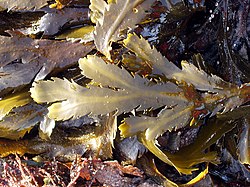| Fucus serratus | |
|---|---|
 | |
| Scientific classification | |
| Domain: | Eukaryota |
| Clade: | Sar |
| Clade: | Stramenopiles |
| Division: | Ochrophyta |
| Class: | Phaeophyceae |
| Order: | Fucales |
| Family: | Fucaceae |
| Genus: | Fucus |
| Species: | F. serratus |
| Binomial name | |
| Fucus serratus | |



Fucus serratus is a seaweed of the north Atlantic Ocean, known as toothed wrack, serrated wrack, [1] or saw wrack. [2] [3]